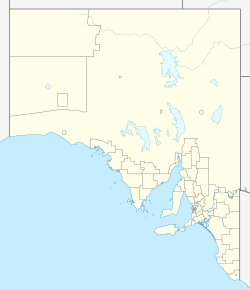Ward Islands (South Australia) facts for kids
| Geography | |
|---|---|
| Location | Great Australian Bight |
| Coordinates | 33°44′38″S 134°17′11″E / 33.74398°S 134.28627°E |
| Highest elevation | 49 m (161 ft) |
| Administration | |
|
Australia
|
|
| Demographics | |
| Population | 0 |
The Ward Islands are a group of islands in South Australia. They are located in the Investigator Group in the Great Australian Bight. These islands are about 53 kilometers (33 miles) southwest of Cape Finniss on the west coast of the Eyre Peninsula.
The famous explorer Matthew Flinders discovered and named these islands. He found them on February 13, 1802. Since the 1960s, the Ward Islands have been a protected area. They are now part of the Investigator Group Wilderness Protection Area.
Contents
About the Islands
The Ward Islands are found off the coast of South Australia. They are about 53 kilometers (33 miles) southwest of Cape Finniss. The town of Elliston is about 57 kilometers (35 miles) to the southwest. The islands are also about 8 nautical miles (15 km) west-northwest of Flinders Island.
The group has two main islands. They are called Ward Island and South Ward Island. Ward Island is also known as the NE islet. South Ward Island is known as the SE Islet.
Ward Island Details
Ward Island is about 20 hectares (49 acres) in size. It rises high above the ocean. Its edges are made of steep cliffs and rocky slopes. The highest point of Ward Island is 49 meters (161 feet) above sea level. This top part is quite flat. It has a layer of soil and some small sand dunes.
South Ward Island Details
South Ward Island is like a small hill made of rock and soil. It reaches a height of 28 meters (92 feet) above sea level. This island is about 2.5 kilometers (1.6 miles) southeast of Ward Island.
Getting to the Islands
It can be very hard to land a boat on Ward Island. The ocean waves and rocky coast make it difficult. Because of this, explorers sometimes use a helicopter to land on the island. For example, a survey team used a helicopter in 1980.
How the Islands Were Made
The Ward Islands were formed a very long time ago. This happened about 9,450 years ago. It was when sea levels started to rise at the beginning of the Holocene period.
Ward Island is what's left of an old hill. It has a core of very old volcanic rock called granite. This rock formed over 1,500 million years ago. The top of the hill was covered by sand. This sand later turned into a type of rock. Ocean waves have worn away much of this rock over time.
The Ward Islands are part of a system of underwater reefs. This system includes many hidden rocks. It also has three separate reefs where waves often break. This reef system stretches about 4 kilometers (2.5 miles) west of Ward Island. It also goes about 3 kilometers (1.9 miles) to the south. The ocean depth reaches 50 meters (160 feet) within 1.2 kilometers (0.75 miles) west of Ward Island.
Plants and Animals
Island Plants (Flora)
In 1980, scientists found 12 different types of plants on the islands. These plants form a low, bushy area called a heath. They are tough plants that can handle salt and strong winds. Three main types of plants grow here.
- Marsh saltbush is common on Ward Island. It grows well in sandy soil.
- Nitre bush prefers soil that contains lime.
- Pointed twinleaf likes orange-colored sandstone soils.
South Ward Island is mostly covered with marsh saltbush. Some large rocks that are always above the water also have this plant.
Island Animals (Fauna)
Many animals have been seen on the Ward Islands. These include Australian sea lions and New Zealand fur seals.
Many different birds also live here or visit. Some of these birds are:
- Short-tailed shearwater
- White-faced storm petrel
- Osprey
- White-bellied sea-eagle
- Richard’s pipit
- Sooty oystercatcher
- Silver gull
- Pacific gull
- Rock parrot
Island History
European Discovery
Matthew Flinders discovered the Ward Islands on February 13, 1802. He reportedly named the islands after his mother's maiden name. On the same day, he also included them as part of the larger Investigator Group.
Protecting the Islands
The Ward Islands first became a protected area in the 1960s. They were set aside as a place to protect animals. In 1972, the islands became part of the Investigator Group Conservation Park.
Later, on August 25, 2011, the Ward Islands were moved. They became part of the Investigator Group Wilderness Protection Area. This means they are now even more protected. Since 2012, the waters around the Ward Islands have also been protected. They are part of a special habitat zone in the Investigator Marine Park. This helps protect the ocean life around the islands.


